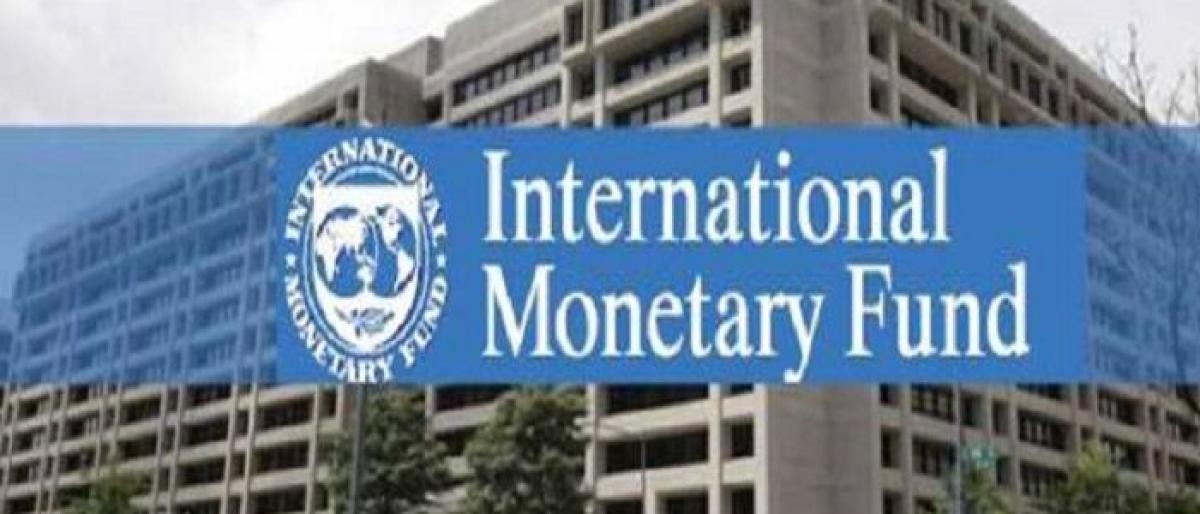Live
- Gentle in manner, resolute in convictions: Sonia Gandhi pens emotional note for Dr. Manmohan Singh
- 2024: A landmark year for India's defence achievements and breakthroughs
- 2025 Horoscopes: Insights and Guidance by Pt. Umesh Chandra Pant
- Osamu Suzuki was a legendary figure in global auto industry: PM Modi
- “AMOEBA”: Celebrating the Journey of Telugu Entrepreneur Sri Motaparti Siva Rama Vara Prasad
- Sachin Khedekar recites a poem from director Feroz Abbas Khan’s powerful new play, ‘Hind 1957’
- NABL-QCI appoints Dr. Sandip Shah as chairperson
- Centre transfers Rs 2.23 lakh crore for 1,206 schemes under Direct Benefit Transfer
- BGT 2024-25: Watching Konstas bat reminds me of Symonds, says Hayden
- 75 iconic lighthouses in India saw more than 10 lakh visitors till September
Just In

India is projected to grow at 73 per cent in 2018 and 74 per cent next year, the IMF said Tuesday in its latest report, predicting India to regain the tag of the worlds fastest growing major economy this year, crossing China with more than 07 percentage points
Washington: India is projected to grow at 7.3 per cent in 2018 and 7.4 per cent next year, the IMF said Tuesday in its latest report, predicting India to regain the tag of the world's fastest growing major economy this year, crossing China with more than 0.7 percentage points.
In 2017, India had clocked a 6.7 per cent growth rate. In India, important reforms have been implemented in the recent years, including the Goods and Services Tax (GST), the inflation-targeting framework, the Insolvency and Bankruptcy Code, and steps to liberalise foreign investment and make it easier to do business, the International Monetary Fund (IMF) said in its latest World Economic Outlook (WEO) report.
"India's growth is expected to increase to 7.3 per cent in 2018 and 7.4 per cent in 2019 (slightly lower than in the April 2018 World Economic Outlook (WEO) for 2019, given the recent increase in oil prices and the tightening of global financial conditions), up from 6.7 per cent in 2017," it said in the WEO report.
This acceleration, the world body said, reflected a rebound from transitory shocks (the currency exchange initiative and implementation of the GST), with strengthening investment and robust private consumption. India's medium-term growth prospects remain strong at 7¾ per cent, benefiting from the ongoing structural reforms, but have been marked down by just under a half percentage point relative to the April 2018 WEO, it said.
If projections are true, then India would regain the tag of the fastest growing major economy of the world, crossing China with more than 0.7 percentage point in 2018 and an impressive 1.2 percentage point growth lead in 2019.
China was the fastest growing economy in 2017 as it was ahead of India by 0.2 percentage points. For the record, the IMF has lowered the growth projections for both India and China by 0.4 per cent and 0.32 per cent, respectively, from its annual April's WEO.
Released in Bali during the annual meeting of the IMF and the World Bank, the IMF's flagship WEO said its 2019 growth projection for China is lower than in April, given the latest round of US tariffs on Chinese imports, as are its projections for India.
In China, growth is projected to moderate from 6.9 per cent in 2017 to 6.6 per cent in 2018 and 6.2 per cent in 2019, reflecting a slowing external demand growth and necessary financial regulatory tightening, the report said.
The 0.2 percentage point downgrade to the 2019 growth forecast is attributable to the negative effect of recent tariff actions, assumed to be partially offset by policy stimulus, it said. Over the medium term, growth is expected to gradually slow to 5.6 per cent as the economy continues to make the transition to a more sustainable growth path with continued financial de-risking and environmental controls, it noted.
"Owing to these changes, our international growth projections for both this year and next are downgraded to 3.7 per cent, 0.2 percentage point below our last assessments and the same rate achieved in 2017," the report said.
The growth rate of the US for 2018 is 2.9 per cent and that of 2019 has been powered to 2.5 per cent. "Looking ahead, renewed impetus to reform labour and land markets, along with further improvements to the business climate are also crucial (in India)," it said.
According to the WEO, in India, reform priorities include reviving bank credit and enhancing the efficiency of credit provision by accelerating the cleanup of bank and corporate balance sheets and improving the governance of public sector banks.
In India, a high interest burden and risks from rising yields require continued focus on debt reduction to establish policy credibility and build buffers.

© 2024 Hyderabad Media House Limited/The Hans India. All rights reserved. Powered by hocalwire.com







